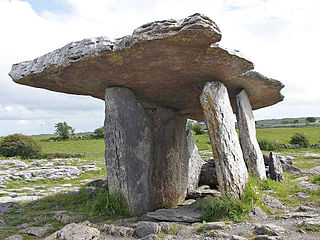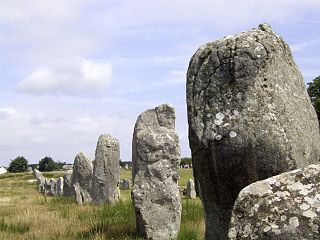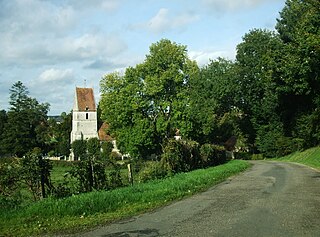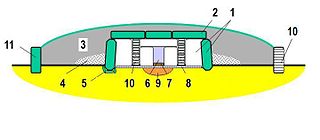
Saumur is a commune in the Maine-et-Loire department in western France.

A gallery grave is a form of megalithic tomb built primarily during the Neolithic Age in Europe in which the main gallery of the tomb is entered without first passing through an antechamber or hallway. There are at least four major types of gallery grave, and they may be covered with an earthen mound or rock mound.

Kilmashogue or Kilmashoge is a mountain in Dún Laoghaire–Rathdown county in Ireland. It is 408 metres high and forms part of the group of hills in the Dublin Mountains which comprises Two Rock, Three Rock, Kilmashogue and Tibradden Mountains. The forest plantation on its northern slope, which is composed mainly of Sitka spruce, Scots pine and beech, is a habitat for Sika deer, hares, rabbits and foxes. A number of prehistoric monuments can be found on the slopes of the mountain.

Montsoreau is a commune of the Loire Valley in the Maine-et-Loire department in western France on the Loire, 160 km (99 mi) from the Atlantic coast and 250 km (160 mi) from Paris. The village is listed among The Most Beautiful Villages of France and is part of the Loire Valley UNESCO World Heritage Site.

The Sieben Steinhäuser is a group of five dolmens on the Lüneburg Heath in the NATO training area of Bergen-Hohne, in the state of Lower Saxony in northern Germany. The stones are considered to be part of the funnelbeaker culture. The gravesite was granted protected cultural monument status in 1923.

Poulnabrone dolmen is a large dolmen located in the Burren, County Clare, Ireland. Situated on one of the most desolate and highest points of the region, it comprises three standing portal stones supporting a heavy horizontal capstone, and dates to the Neolithic period, with estimates to between 4200 BC and 2900 BC. Although not the largest, it is the best known of the approximately 172 dolmens in Ireland.

The Carnac stones are an exceptionally dense collection of megalithic sites near the south coast of Brittany in northwestern France, consisting of stone alignments (rows), dolmens, tumuli and single menhirs. More than 3,000 prehistoric standing stones were hewn from local granite and erected by the pre-Celtic people of Brittany and form the largest such collection in the world. Most of the stones are within the Breton municipality of Carnac, but some to the east are within neighboring La Trinité-sur-Mer. The stones were erected at some stage during the Neolithic period, probably around 3300 BC, but some may date to as early as 4500 BC.

Pentre Ifan is the name of an ancient manor in the community and parish of Nevern, Pembrokeshire, Wales. It is 11 miles (18 km) from Cardigan, Ceredigion, and 3 miles (4.8 km) east of Newport, Pembrokeshire. Pentre Ifan contains and gives its name to the largest and best preserved neolithic dolmen in Wales.

Concentrations of megaliths, dolmens and stone labyrinths dating between the end of the 4th millennium and the beginning of the 2nd millennium B.C. have been found throughout the Caucasus Mountains, including Abkhazia. Most of them are represented by rectangular structures made of stone slabs or cut in rocks with holes in their facade. These dolmens cover the Western Caucasus on both sides of the mountain ridge, in an area of approximately 12,000 square kilometres of Russia and Abkhazia.

The dolmens of Jersey are neolithic sites, including dolmens, in Jersey. They range over a wide period, from around 4800 BC to 2250 BC, these dates covering the periods roughly designated as Neolithic, or “new stone age”, to Chalcolithic, or “copper age”.

The Tumulus of Bougon or Necropolis of Bougon is a group of five Neolithic barrows located in Bougon, near La-Mothe-Saint-Héray, between Exoudun and Pamproux in Nouvelle-Aquitaine, France.

Habloville is a commune in the Orne department in north-western France. The inhabitants of Habloville,are called Hablovillais and Hablovillaises
Peyre-Brune is a Neolithic dolmen situated near Saint-Aquilin in the department of the Dordogne, France.

Nordic megalith architecture is an ancient architectural style found in Northern Europe, especially Scandinavia and North Germany, that involves large slabs of stone arranged to form a structure. It emerged in northern Europe, predominantly between 3500 and 2800 BC. It was primarily a product of the Funnelbeaker culture. Between 1964 and 1974, Ewald Schuldt in Mecklenburg-Western Pomerania excavated over 100 sites of different types: simple dolmens, extended dolmens, passage graves, great dolmens, unchambered long barrows, and stone cists. In addition, there are polygonal dolmens and types that emerged later, for example, the Grabkiste and Röse. This nomenclature, which specifically derives from the German, is not used in Scandinavia where these sites are categorised by other, more general, terms, as dolmens, passage graves and stone cists.

The dolmen del prado de Lácara is a megalithic monument known as a passage tomb. It is located northwest of the Spanish city of Mérida, in the province of Badajoz. It is located next to the EX-214 road, which connects Aljucén with La Nava de Santiago. It is a notable megalithic tomb, built during the late Neolithic towards the end of the 4th millennium BC or early 3rd millennium BC. It is one of the most monumental and well preserved sites in the Extremadura region, which is why it was declared a site of cultural interest in 1912 and a National Monument in 1931.

A threshold stone or sill stone is a rectangularly dressed stone slab that forms part of the entrance of megalithic tombs of the Funnelbeaker culture, normally those with a passage. The red sandstone slab, up to 0.1 metres thick, was buried in the ground to a depth of 0.2 metres at the entrance to the chamber. Cultural sites of other types, such as Domus de Janas, also have a clear partition between the passage and the ante-chamber or main chamber.

La Roche-aux-Fées is a Neolithic gallery grave, or dolmen, located in the commune of Essé, in the French department of Ille-et-Vilaine in Brittany. Its name comes from a legend that claims that the stones were placed by fairies. The dolmen consists of more than forty stones forming a corridor four times longer than wide. Its northwest-southeast axis is on an alignment with sunrise at the winter solstice.
Carricknagat Megalithic Tombs are megalithic tombs and a National Monument located in County Sligo, Ireland.

The Déhus dolmen is a Neolithic dolmen located in the parish of Clos du Valle on the island of Guernsey.




















